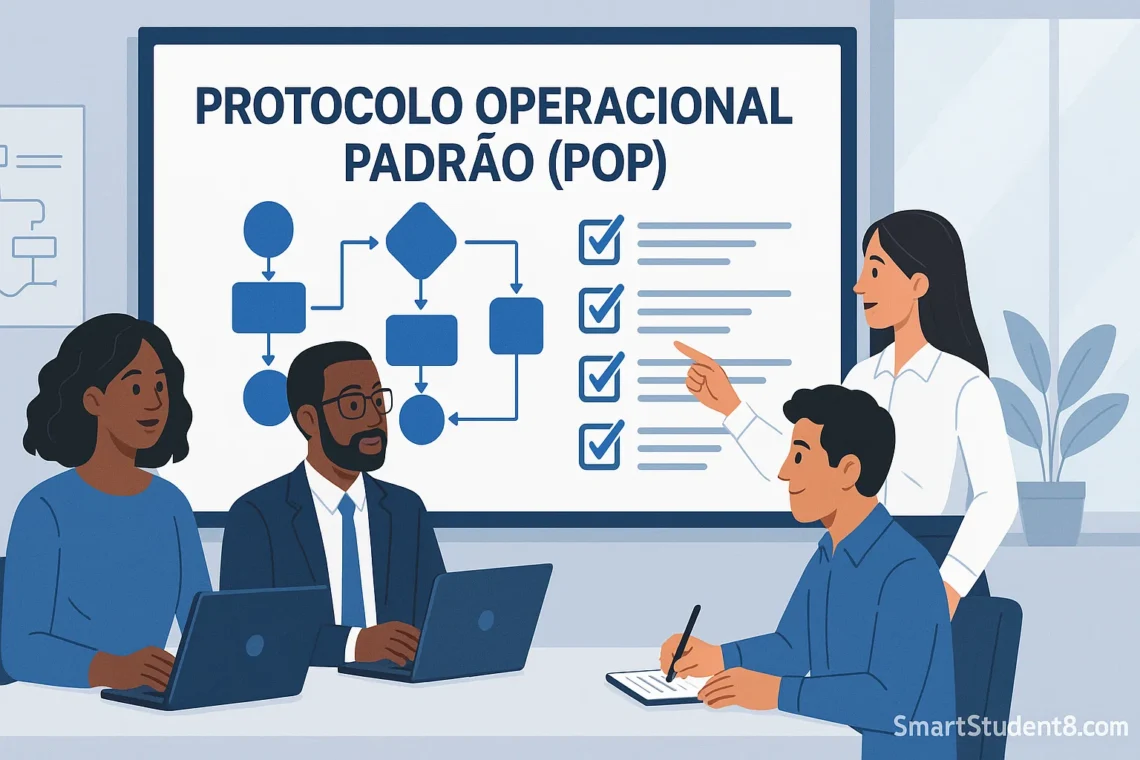From a start-up to a multi-national corporation, quality and efficiency are based on consistency. How can you guarantee that an important task will be performed with the highest level of quality and consistency, regardless of the person performing it? Standard Operating Procedure (SOP), also known as Protocolo Operacional Padrao in Portuguese, is a useful tool, but it’s often forgotten. After years of implementing them in different operational settings, I have seen how they transform a messy workflow into an efficient one. The documents you create are far more than simple instructions. They form the basis of operational excellence. This guide will show you everything you need in order to implement and create effective SOPs.
What is a Standard Operating Procedure (SOP/POP)?
Standard Operating Procedures (SOPs), also known as Protocolo Operacional Padrão are documents that provide detailed and step-bystep instructions about how to complete a task or procedure. You can think of it as the recipe for an entire business. SOPs are like recipes that guarantee a chef the ability to produce the same tasty dish time after time. They also make sure an employee is able to perform a task at the same quality, efficiency, and safety standard.
The SOP eliminates uncertainty, reduces variance, and establishes one, approved way to perform routine activities. Three different shifts of a manufacturing group produced remarkably different results. Day shift was most productive but night shift made the least mistakes. The SOP we created by documenting all the techniques used in each shift was a unified one. This allowed us to increase the efficiency of the whole operation and decrease defects 15% within 3 months. It was this experience that taught me an SOP wasn’t just about controlling everything. Instead, it is about collecting collective wisdom and allowing everyone to access it.
Workflow Standardization as a Core Objective
Standardization of the workflow is the primary purpose for implementing a SOP. Once processes are standardised, they can be standardized to make them predictable, measurable and optimized. For several reasons, consistency is essential. The consistency ensures the customers are receiving the same level of service and product, building trust and loyalty. In the workplace, standardization reduces employee learning curves, simplifies internal training and makes performance evaluation easier.
Standardization also provides the basis for ongoing improvement. It is impossible to improve a system that has not been consistently implemented. After you establish a solid baseline, it is possible to experiment with different changes and accurately measure the impact of those experiments. Standardization is a foundation that can be used to create an organization with greater efficiency and scale.
How important is process optimization to your business?
The natural progression from standardization to process optimization is called “process optimization”. You can start improving your procedures once you’ve documented them and standardized them. The real competitive advantage can be found here. The optimized process requires fewer resources, such as less time, money or materials, to achieve a superior outcome. My company worked with a shipping firm that struggled with processing times. They had a very basic SOP at first. Analyzing the data of this standardized process, we found a delay that was recurring in the final step.
In order to reduce the time it took for a manual sequential check, we implemented a new parallel verification process using a barcode scanner. A small adjustment, based on a standardized process, brought down the processing time average by 20%. Herein lies the power of optimizing. Work smarter, not harder. The result is a reduction in waste, an increase in productivity and a direct impact on your bottom-line. Capital and resources can be used to concentrate on growth and innovation.
How to Create an Effective Standard Operating Procedure Document
Effective SOPs are more than a set of instructions. For a SOP to be useful, it needs to be comprehensive and easy-to-use. This document should contain the required information so that an employee can perform their task properly and safely. Although the format may vary, an effective SOP must always have several essential components. A poorly-written SOP will only cause further confusion. This document must be detailed and clear enough for an experienced veteran to use as a reference, but also simple enough to allow a novice to easily follow.
What should every SOP contain?
- Title & Identification: A document must have a title that’s clear (e.g. SOP for processing customer refunds), a version number, as well as the date it was created and its last revision.
- Objective: Briefly stating the SOP’s objective. Why is this process in place, and what outcome do you want?
- Scope: This section defines boundaries for the SOP. Which departments, roles or situations are covered by this SOP?
- Roles, Responsibilities and Accountability: Indicate who is in charge of each stage. Keep the document up-to-date by using job titles, rather than names.
- Material and Equipment Requirements: List any tools, programs, safety equipment, (like the EPIs – Equpamentos de Protecao Individuo), or other resources that are needed to accomplish the task.
- Procedure Step-by step: Here is the core of the SOP. Detail each step using simple, clear language in an active voice. If possible, use screenshots or illustrations.
- QA/QC: Describe what a “good” outcome is. Include metrics and success criteria. How can the supervisor or employee know that the task has been completed?
- Safety Warnings: In the event that a task is dangerous, it must include all necessary safety instructions and precautions.
The Different Types Of Standard Operating Procedures
There is no one-size fits-all SOP. SOPs are not a one-size-fits all solution. The format you choose depends on your SOP and your team’s needs. If you force a multi-stage, complex process into a check list, it will result in errors. Similarly, complicating an easy task by using a hierarchy will frustrate the employees. It is important to choose the correct format for users and their effectiveness.
In a lab project, we discovered that technicians required different formats to perform different tasks. Simple checklists were the fastest for routine sample recording. To ensure accuracy, and to prevent costly mistakes when operating a diagnostic device that is complex, you need a detailed step-bystep guide.
Here are some examples of common formats.
- Simple check list: This is best for linear, straightforward processes. The user just needs to ensure that the steps are completed. The simple checklist is ideal for tasks such as opening the retail store each day, or performing a quality check.
- Step by step guide: Usually, this format is used to provide a detailed list of instructions with numbers or bullets. Ideal for simple tasks that don’t require complex decision points but do need a sequenced of actions.
- Steps in a Hierarchical Order: When presenting more complex processes with many phases, the format divides major steps into more manageable, smaller sub-steps. This helps to prevent the user from becoming overwhelmed, and it provides a logical framework.
- Diagram: Ideal for processes with many decision points or outcomes. They use symbols to represent the flow of work, so it’s easy to visualize how various choices will lead down different paths. The flowcharts are perfect for customer service processes or troubleshooting.
The 6 Steps to Writing a Simple SOP
The task of writing an SOP may seem daunting, but by breaking it into a process that is structured it can become manageable. Not only is it important to produce a useful document, but you also need to make sure that the tool will be used by people. My experience has shown that SOPs with the greatest success aren’t written by an administrator in a corporate office, but are created in conjunction with people who actually do the job every day. The people who perform the work every day are true experts. It is your role to guide the process and document their knowledge in a consistent, clear format.
You can follow this six-step program to help guide you.
- Define Goal and Scope : First, identify a process in need of standardization. Question yourself: Which task will we be documenting? Why is this important? Who will be using this SOP. The purpose of the SOP and its audience will be determined by answering these questions.
- Gather information: Interact with the users. Take detailed notes, observe and ask questions about the processes. Working with the team, identify the most effective method if there are several ways to perform the task.
- Pick the right format: According to the complexity of the process, you can choose from a list, a step-by-step flowchart or hierarchy.
- Draft your SOP. Write a first draft with the information that you have gathered. Be sure to use plain, simple language. From the users’ perspective, write.
- Re-read and test:. This step is critical. Test the employee’s ability to perform the job using just the SOP. Ask the experienced employees to review and confirm accuracy. Incorporate all feedback.
- Incorporate, train, and evaluate: As soon as the standard operating procedure is approved, it should be implemented. Train all staff members to make sure they are familiar with the new procedures. Schedule regular reviews to keep the SOP current.
What is the difference between Work Instructions and SOPs?
SOPs are used in many cases interchangeably with Work Instructions, but they serve different purposes. They also operate on a different level of detail. The two documents can be confused and result in either too much detail, or too little information. The SOP is a high-level summary of the process that explains “what” and why, while Work Instructions provide granular detail on how to complete a particular step.
Consider an SOP as a detailed itinerary of your trip, including flights, hotels, and the key locations. An Instruction to Work is similar to GPS instructions to help you get from your airport to first hotel. They are both necessary to have a great trip. But they perform different roles.
| The Feature | Standard Operating Procedure (SOP). | Work Instruction |
|---|---|---|
| Scope | The workflow or process is covered in its entirety. | A single step or task within a SOP. |
| The Purpose | To maintain consistency, quality and safety throughout a whole process. | To give detailed instructions, including step-bystep directions for performing a particular action. |
| Details | High-level. Description of the order in which major tasks are performed. | Detailed. Describes exactly what to do. |
| Exemple | The SOP on “Onboarding of a New employee.” | This Work Instruction describes “How to setup an employee’s email Account.” |
This distinction is crucial. It would take a hundred pages to set up each software program. In the SOP, it should read, “Step 4: Create software accounts according to WI-IT-014”. This will direct the user towards the Work Instruction for more detailed instructions.
How SOPs can help with Quality Assurance and Compliance
SOPs can be a great idea, but they are also necessary for industries that are subject to strict rules, such as the pharmaceutical, food, and health care sectors. These SOPs form the basis of a Quality Management System (QMS), and they are crucial for achieving ISO 9001 certification and keeping it. Inspectors aren’t satisfied with hearing that your company follows best practices. They also want proof. These SOPs can be verified. These documents show that you have formalized your processes, properly trained and supervised staff, as well as put mechanisms into place to maintain quality and consistency. SOPs are a safeguard that ensures that the safety of employees and clients is maintained by following established quality and safety standards.
Continuous Improvement: The Living Nature of SOPs
A company’s biggest Mistake is to draft an SOP then put it into a file and ignore it. It is important that a Standard Operating procedure be an ever-evolving document. New technologies, better methods, and changes in your business are all part of the evolution. As your business evolves, so must your standard operating procedures. SOPs are not rigid rules that must be followed. They should instead be seen by teams as the “best way to do it” at any given time. This mentality fosters an improvement culture.
The employees must be given the power to improve an SOP if they can find a quicker, safer, or better way to accomplish a certain task. You can ensure your documentation reflects the realities of your business by establishing an official review and updating process. The iterative standardization, measuring, and optimizing process is what transforms an average company into one that excels.
Read More: The Ultimate Guide to PLG Supplies: More Than Just Products
Conclusions
Implementing a Protocolo Opcional Padrao is a powerful step to ensure that your organization operates with high standards, efficiency, and consistency. The right SOPs can be the basis for effective training, regulatory compliance, improvement of processes, and reduction of risk. These SOPs help to preserve the institutional knowledge of the organization, minimize errors and establish the standards for the way work should be carried out, regardless of who does the job. It is only when the POP becomes a dynamic tool that changes with business reality, can it truly be considered valuable.
Regularly reviewing and updating your procedures, while involving all members of the team, will create an environment where improvement isn’t a goal, but a journey. By prioritizing the creation and maintenance of well-crafted SOPs, you will not only be protecting your business, but will also empower your staff, boost productivity and ensure operational success for years to come.





